The Gagosian EffectHow the powerful art dealer uses his global network of galleries and blue-chip clients to fetch ever higher prices for his artists. Can it last?.
Over Oscar weekend in late February, art dealer Larry Gagosian held a private lunch at the $15.5 million home he recently bought in the Holmby Hills section of Los Angeles. His glass-enclosed house had been decorated for the occasion by the artist Richard Prince, so its walls were lined with his portraits of beach beauties and pulp-novel nurses.
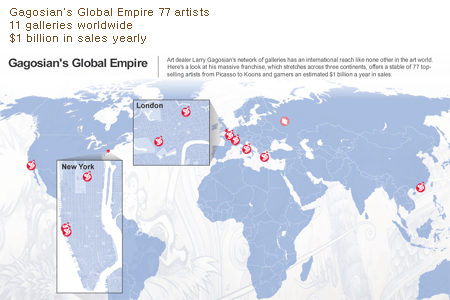
As guests including financier Ron Perelman and actress Renée Zellweger navigated the home's skylit hallways, Mr. Gagosian and his staff mingled with guests, discreetly passing a rolled-up sheet of paper between them like a baton. The sheet listed prices for nearly every artwork in sight.
With an unrelenting focus on selling, Mr. Gagosian, 65, has become the most powerful art dealer in the world. He represents the estates and careers of 77 of the world's top artists, including Pablo Picasso, Alberto Giacometti, Cy Twombly, Richard Serra, Jeff Koons, Damien Hirst and Ed Ruscha. Dealers who track how he prices his gallery shows estimate he sells upwards of $1 billion worth of art a year. Sotheby's, by comparison, auctioned off $870 million worth of contemporary art last year.
As the contemporary art market rebounds from the recession, Mr. Gagosian's art empire is exploding. In the last few years, he has opened new galleries in London, Paris, Rome, Geneva, Athens and Hong Kong, expanding his global art network to 11 galleries world-wide—the largest blue-chip franchise ever attempted in the industry.
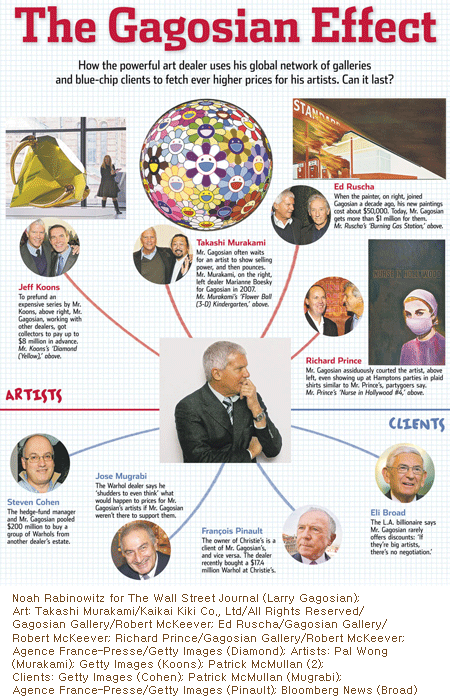
Mr. Gagosian's position affords him a lifestyle on par with his billionaire clients, who include hedge-fund manager Steven Cohen, money manager Leon Black, Christie's owner Francois Pinault and billionaire philanthropist Eli Broad. He flies in a roughly $40 million Bombardier Global Express private jet and has a personal chef on call at his Madison Avenue headquarters. He has homes in New York, the Hamptons and St. Bart's in addition to his home in Los Angeles, speckled with his own collection of vintage photographs, Giacometti busts and canvases by Picasso and Andy Warhol.
Rapid global expansion has its risks. Mr. Gagosian now needs to supply about 60 distinct shows a year with fresh art. Collectors in Rome and Paris so far have shown little inclination to buy million-dollar contemporary art. And it was only two years ago that prices for some of Mr. Gagosian's trendiest artists, like Mr. Hirst, plummeted at auction. Contemporary art, the most volatile segment of the art market, remains subject to sudden, improbable leaps and jarring crashes.
There's also the question of a succession plan. The Los Angeles son of Armenian-American parents, Mr. Gagosian got his start peddling framed posters at a markup for $15 apiece. Since 1979 he has built his gallery empire largely on his own hard-charging deal-making abilities—he still conducts many of his biggest sales himself—and it's not clear who will eventually replace him as the head of his business. The dealer says he "lives in complete denial" about a successor. It's a critical issue, since Mr. Gagosian plays such a central role in elevating and maintaining the amount paid for his artists' work.
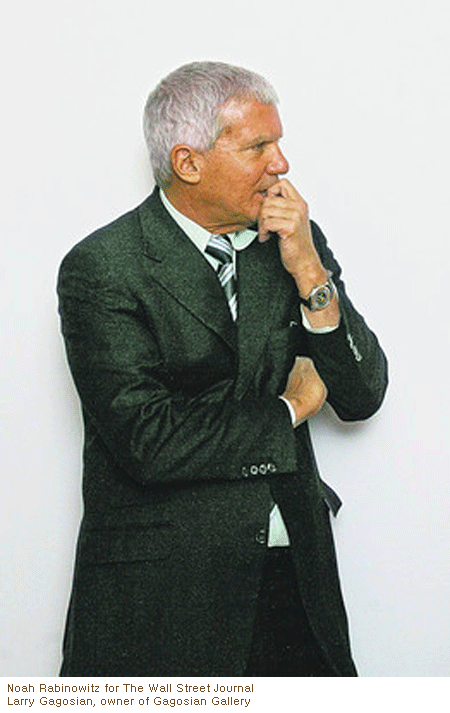
When asked what would happen to the market prices for Mr. Gagosian's artists without the dealer there to support them, Jose Mugrabi, a major Warhol dealer who sometimes consigns pieces to Mr. Gagosian's shows, said simply, "I shudder to even think of it."
To fuel his expanded enterprise, Mr. Gagosian is rapidly recruiting new artists. Over the past year, he has added sculptor John Chamberlain, photographer Andreas Gursky, installation artist James Turrell, and the estates of painters Robert Rauschenberg and Kazimir Malevich to his roster. He has also mounted a show with conceptual artist Rudolf Stingel, who still shows with the Paula Cooper Gallery, and last week, he began planning a show with Urs Fischer, an installation artist who still shows with Gavin Brown.
Unlike other dealers, who often spend decades helping to nurture and promote artists on their way up, Mr. Gagosian typically waits until an artist's market is poised to skyrocket—after a big museum show or an auction spike—and then he pounces. The dealer recruited nearly all of his current artists from rival galleries.
This approach has helped him build an enviable stable, but it has also earned him enemies. Dealer David Zwirner said Mr. Gagosian is known for "aggressively poaching" talent from his peers. Mr. Gagosian has never joined his industry's top club, the Art Dealers Association of America. President Lucy Mitchell-Innes said potential members need to be nominated but demurred on whether he had been.
"When a great artist gets my attention, I pursue it," Mr. Gagosian said, sitting behind his paper-strewn desk in New York. "If I don't, someone else will, you know what I'm saying?"
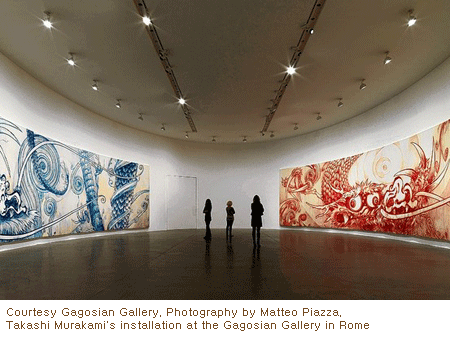
Three months ago, Mr. Gagosian paid a visit to Mr. Chamberlain, the sculptor, in Shelter Island, N.Y. Mr. Chamberlain, 83, had built an acclaimed career twisting metal car parts into colorful abstract bundles. For the past three decades, he had sold much of this work through Pace, a major New York gallery. At auction, his pieces have sold for between $1 million and $4.6 million. But recently, Pace had declined to buy some pieces that Mr. Chamberlain had made with a Belgian fabricator under his supervision, rather than doing the hands-on sculpting himself. So when Mr. Gagosian asked to visit, Mr. Chamberlain agreed, pointing the dealer toward his art-filled studio while he waited in the living room.
Mr. Gagosian, blue-eyed with short, silver hair, returned grinning minutes later and told the artist: "I want it all," Mr. Chamberlain recalled.
Dealers who have seen the works in Mr. Chamberlain's studio say their value could approach $20 million. The artist formally broke with Pace a few weeks later; his first show with Gagosian Gallery opens in May. Pace declined to comment on his decision.
"Sometimes artists need to shift gears, and Larry is always ready to go," Mr. Chamberlain said. "What should I do, sit in a corner?"
Mr. Gagosian does not characterize his methods as poaching. "Usually when an artist joins the gallery, it's because they want to make a move," he said.
There's a reason that many artists are willing to leave dealers who have nurtured them for years to join Mr. Gagosian's camp: Once they do, their prices often rise precipitously. Twelve years ago, Cecily Brown's swirling abstractions were selling for as little as $8,000 when Mr. Gagosian ushered her into the fold and encouraged curators from the Tate and the Museum of Modern Art to buy her work. Today, Ms. Brown's new paintings sell for around $800,000, the gallery says.
Miami collector Dennis Scholl says he can no longer afford to buy artists once they join the gallery because their prices ratchet up so quickly, sometimes doubling in less than a year. "Once he seduces someone, they get really expensive," Mr. Scholl said.
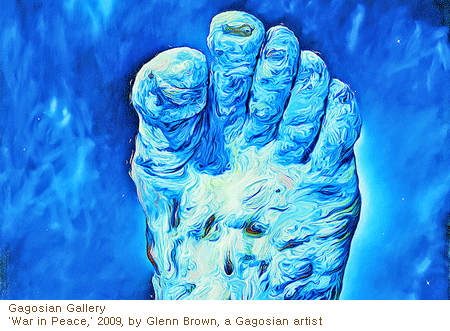
In the contemporary art market, there is no standard formula for determining what an artist is worth. It's famously difficult to determine which artist will have lasting cultural significance over decades or centuries, and which will be a flash in the pan. This gives top dealers like Mr. Gagosian enormous power to influence and even set the markets for the artists they represent. Anyone who wants his art must pay his prices.
"Sometimes we don't know if the stuff we're buying is historically significant, but because the prices are so high, we need to believe they're important," said Dallas collector Howard Rachofsky, a Gagosian client.
Private dealer Richard Polsky says that in many cases, when collectors buy from Mr. Gagosian, what they're really buying is Mr. Gagosian's cachet: "You cannot underestimate the egos of the people who buy from Gagosian. Most would rather overpay to be part of his world, and he counts on that mystique to draw clients to him."
Mr. Gagosian's courtship of Mr. Prince, the painter and photographer, is a case study in the dealer's combination of market timing and perseverance. In 2004, Mr. Prince's dealers at the time were getting as much as $70,000 for his "Nurse" paintings, in which the artist layered paint over images of nurses culled from 1950s paperback novels. Mr. Gagosian began inviting the artist to social events. The next year, as the contemporary art market began to soar, Mr. Prince's prices started skyrocketing at auction. That year, Mr. Gagosian invited Mr. Prince to show at his Beverly Hills gallery, and began including his works in group shows at his galleries.
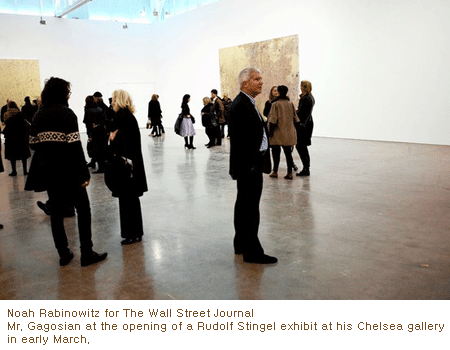
An instantly recognizable figure at auctions, always taking a seat up front and on the aisle, Mr. Gagosian usually bids on a few big-ticket paintings at any major sale, either for his gallery or for clients. During the last big round of sales in London, he bought the week's priciest piece, Christie's $17.4 million Andy Warhol self-portrait. He declined to say whether he plans to keep it or resell it.
Over the years, he's honed another technique to foster big-ticket sales: encouraging his artists to make supersized works, which can translate to supersized sales prices. When artists join his gallery, Mr. Gagosian often puts up the money or enlists collectors to prepay for his artists' most ambitious projects.
Last fall, Anselm Kiefer needed 50 workers and more than $1 million, provided by Mr. Gagosian, just to install his New York gallery show, which comprised a series of 27 towering glass vitrines filled with war-torn ephemera and airplane parts, totalling over 60 tons. The gallery says that nearly all found buyers.
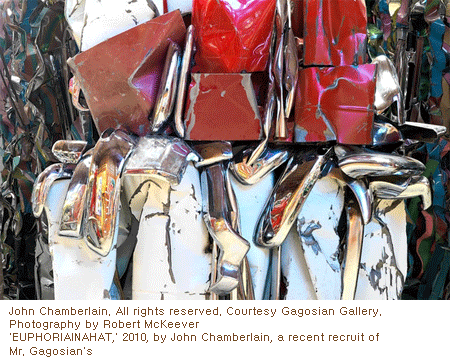
To finance Jeff Koons's giant "Celebration" sculptures, a consortium of dealers, including Mr. Gagosian, spent years helping the artist line up buyers willing to prepay for them. The buyers paid $2 million to $8 million apiece to own one of the artist' car-sized sculptures of balloon dogs and candy-colored hearts.
For the new owners, selling at auction provided a big payoff. In November 2007, Sotheby's sold a pink heart-shaped sculpture from the series for $23.6 million, then a record price for a living artist; the next summer, as banks teetered, Christie's sold Howard Rachofsky's pink balloon-flower from the same series for $25.7 million. None of the artist's paintings or smaller sculptures has sold for even half that much at auction.
Not every artist thrives under Gagosian-scale conditions, though. In the past couple years, several artists have left the stable for smaller outfits, including Tom Friedman, Mark di Suvero and Ghada Amer. The estate of Willem de Kooning, once a pillar of the gallery program, also went to rival Pace recently.
Artists that Mr. Gagosian still wants, according to sources at his gallery, include Zeng Fanzhi, Rirkrit Tiravanija and Ai WeiWei. Mr. Gagosian said he recently met with Jasper Johns, who at age 80 shows with dealer Matthew Marks, but added, "Jasper seems happy with his gallery." Mr. Johns confirmed through Mr. Marks that they "had a cup of coffee."
Mr. Gagosian employs a far-flung staff of close to 150, many hired from auction houses, museums and banks, to manage his empire. Sales directors at each gallery are assigned a few artists apiece, like account managers. In London, for example, Millicent Wilner, who has the account for Mr. Hirst, says she calls or emails the artist daily. Directors earn a 10% slice of the gallery's commission whenever they close a sale, and a New York gallery director for Gagosian, Sam Orlofsky, said his colleagues often jockey for the right to sell the most coveted pieces in any show. "Sometimes it feels a little 'Glengarry Glen Ross,'" Mr. Orlofsky said, referring to the David Mamet play about real-estate salesmen fighting over leads.
In New York, Los Angeles and London, which have booming contemporary-art collecting scenes, Mr. Gagosian's galleries have thrived. But he faces bigger challenges at his outposts in France and Rome, where some collectors have more conservative tastes or gravitate to lower-priced contemporary art.
Rome has only a handful of contemporary collectors who are willing to pay Mr. Gagosian's "entry-level prices," said Pepi Marchetti-Franchi, who manages the dealer's three-year-old branch near the Spanish Steps. A majority of the works shown in Rome wind up selling to collectors elsewhere in Italy or abroad, she said. A similar dynamic is also at work, to a lesser degree, in the gallery's smaller showrooms in Athens and Geneva. Mr. Gagosian said it doesn't matter to him at the outset whether these pieces sell to locals or his regular clientele, so long as they sell.
Takashi Murakami hasn't exhibited much work in Italy, so the gallery made much of his show in Rome last November. On opening night, Mr. Murakami and roughly 100 gallery guests got a private tour of the Sistine Chapel, followed by dinner in another room of the Vatican studded with marble statues. Mr. Murakami's pair of 58-foot paintings in the gallery still wound up selling to collectors in the U.S. and Asia.
To succeed in the long run, these outposts will need to cultivate more local buyers to justify Mr. Gagosian's lavish outlay, says art-market analyst Sergey Skaterschikov. "It may take five years before his new galleries even start to pay off."
Plans are on hold, for now, to expand anywhere else, Mr. Gagosian said. He conceded he did some "exploring" in the Middle East last fall when he exhibited roughly $1 billion worth of art from his personal collection in a new pavilion on Abu Dhabi's Saadiyat Island, where the government is building offshoots of the Louvre and the Guggenheim museums.
His greatest chance for faraway profits may lie with Hong Kong, where his gallery opened a space in the Central district two months ago. He's renting the top floor of a colonial building with an 8-foot-tall elevator, so workers installing Mr. Hirst's inaugural show there had to hoist the artist's 10-foot sculpture of Saint Bartholomew up through the stairwell.
Questions of local taste pervaded the launch: Mr. Hirst's gold-plated sculpture depicts a gruesome classic—the martyr holding his own flayed skin—yet the artist added a gold fig leaf to the nude before its Hong Kong debut. "There was some feeling it might offend," Ms. Wilner said. The saint's three editions sold within the first week, however, all to Asian buyers.
Mr. Gagosian said the Hong Kong launch means he's always got a gallery open somewhere in the world, no matter the time zone. "The sun never sets on my gallery," he said.






